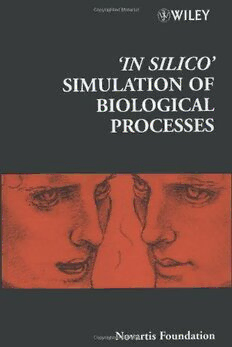
'In silico' simulation of biological processes PDF
Preview 'In silico' simulation of biological processes
‘InSilico’SimulationofBiologicalProcesses:NovartisFoundationSymposium,Volume247 EditedbyGregoryBockandJamieA.Goode Copyright(cid:182)NovartisFoundation2002. ISBN:0-470-84480-9 ‘INSILICO’ SIMULATION OF BIOLOGICAL PROCESSES TheNovartisFoundationisaninternationalscienti¢candeducational charity(UKRegisteredCharityNo.313574).KnownuntilSeptember1997 astheCibaFoundation,itwasestablishedin1947bytheCIBAcompany ofBasle,whichmergedwithSandozin1996,toformNovartis.The FoundationoperatesindependentlyinLondonunderEnglishtrust law.Itwasformallyopenedon22June1949. TheFoundationpromotesthestudyandgeneralknowledgeof scienceandinparticularencouragesinternationalco-operationin scienti¢cresearch.Tothisend,itorganizesinternationally acclaimedmeetings(typicallyeightsymposiaandalliedopen meetingsand15^20discussionmeetingseachyear)andpublishes eightbooksperyearfeaturingthepresentedpapersanddiscussions fromthesymposia.Althoughprimarilyanoperationalratherthan agrant-makingfoundation,itawardsbursariestoyoungscientists toattendthesymposiaandafterwardsworkwithoneoftheother participants. TheFoundation’sheadquartersat41PortlandPlace,LondonW1B1BN, providelibraryfacilities,opentograduatesinscienceandallieddisciplines. Mediarelationsarefosteredbyregularpressconferencesandbyarticles preparedbytheFoundation’sScienceWriterinResidence.TheFoundation o¡ersaccommodationandmeetingfacilitiestovisitingscientistsandtheir societies. InformationonallFoundationactivitiescanbefoundat http://www.novartisfound.org.uk Novartis Foundation Symposium 247 ‘IN SILICO’ SIMULATION OF BIOLOGICAL PROCESSES 2002 JOHN WILEY&SONS,LTD Copyright&NovartisFoundation2002 Publishedin2002byJohnWiley&SonsLtd, TheAtrium,SouthernGate, Chichester,WestSussexPO198SQ,UK National 01243779777 International(+44)1243779777 e-mail(forordersandcustomerserviceenquiries):[email protected] VisitourHomePageonhttp://www.wileyeurope.com orhttp://www.wiley.com AllRightsReserved.Nopartofthisbookmaybereproduced,storedinaretrieval systemortransmittedinanyformorbyanymeans,electronic,mechanical,photocopying, recording,scanningorotherwise,exceptunderthetermsoftheCopyright,Designsand PatentsAct1988orunderthetermsofalicenceissuedbytheCopyrightLicensingAgencyLtd, 90TottenhamCourtRoad,LondonW1T4LP,UK,withoutthepermissioninwriting ofthePublisher.RequeststothePublishershouldbeaddressedtothePermissionsDepartment, JohnWiley&SonsLtd,TheAtrium,SouthernGate,Chichester,WestSussexPO198SQ, England,[email protected],orfaxedto(+44)1243770620. Thispublicationisdesignedtoprovideaccurateandauthoritativeinformationinregardto thesubjectmattercovered.ItissoldontheunderstandingthatthePublisherisnotengaged inrenderingprofessionalservices.Ifprofessionaladviceorotherexpertassistanceis required,theservicesofacompetentprofessionalshouldbesought. OtherWileyEditorialO⁄ces JohnWiley&SonsInc.,111RiverStreet,Hoboken,NJ07030,USA Jossey-Bass,989MarketStreet,SanFrancisco,CA94103-1741,USA Wiley-VCHVerlagGmbH,Boschstr.12,D-69469Weinheim,Germany JohnWiley&SonsAustraliaLtd,33ParkRoad,Milton,Queensland4064,Australia JohnWiley&Sons(Asia)PteLtd,2ClementiLoop#02-01,JinXingDistripark,Singapore 129809 JohnWiley&SonsCanadaLtd,22WorcesterRoad,Etobicoke,Ontario,CanadaM9W1L1 Wileyalsopublishesitsbooksinavarietyofelectronicformats.Somecontentthatappears inprintmaynotbeavailableinelectronicbooks. NovartisFoundationSymposium247 viii+262pages,39¢gures,5tables LibraryofCongressCataloging-in-PublicationData ‘Insilico’simulationofbiologicalprocesses/[editors,GregoryBockandJamieA.Goode. p.cm.^(NovartisFoundationsymposium;247) ‘‘Symposiumon‘Insilico’simulationofbiologicalprocesses,heldattheNovartis Foundation,London,27^29November2001’’^Contentsp. Includesbibliographicalreferencesandindex. ISBN0-470-84480-9(alk.paper) 1.Biology^Computersimulation^Congresses.2.Bioinformatics^Congresses. I. Bock,Gregory. II.Goode,Jamie. III.Symposiumon‘InSilico’SimulationofBiological Processes(2001:London,England) IV.Series. QH324.2.I52003 570’.1’13^dc21 2002035730 BritishLibraryCataloguinginPublicationData AcataloguerecordforthisbookisavailablefromtheBritishLibrary ISBN0470844809 Typesetin101(cid:1) on121(cid:1) ptGaramondbyDobbieTypesettingLimited,Tavistock,Devon. 2 2 PrintedandboundinGreatBritainbyBiddlesLtd,GuildfordandKing’sLynn. Thisbookisprintedonacid-freepaperresponsiblymanufacturedfromsustainableforestry, inwhichatleasttwotreesareplantedforeachoneusedforpaperproduction. Contents Symposiumon‘Insilico’simulationofbiologicalprocesses,heldattheNovartisFoundation, London,27^29November2001 Editors:GregoryBock(Organizer)andJamieA.Goode ThissymposiumisbasedonaproposalmadebyDrPaulHerrling DenisNoble Chair’sintroduction 1 AndrewD.McCullochandGaryHuber Integrativebiologicalmodelling insilico 4 Discussion 20 MikeGiles Advancesincomputing,andtheirimpactonscienti¢ccomputing 26 Discussion 34 DavidKrakauer Fromphysicstophenomenology.Levelsofdescriptionand levelsofselection 42 PhilipK.Maini Makingsenseofcomplexphenomenainbiology 53 Discussion 60 MichaelAshburnerandSuzannaLewis Onontologiesforbiologists: theGeneOntology(cid:1)untanglingtheweb 66 Discussion 80 GeneraldiscussionI Modelvalidation 84 MinoruKanehisa TheKEGGdatabase 91 Discussion 101 ShankarSubramaniamandtheBioinformaticsCoreLaboratoryBioinformaticsof cellularsignalling 104 Discussion 116 vi CONTENTS GeneraldiscussionII Standardsofcommunication 119 Semanticsandintercommunicability 121 RaimondL.Winslow,PatrickHelm,WilliamBaumgartnerJr.,SrinivasPeddi, TilakRatnanather,ElliotMcVeighandMichaelI.Miller Imaging-based integrativemodelsoftheheart:closingtheloopbetweenexperimentand simulation 129 Discussion 141 GeneraldiscussionIII ModellingCa2+signalling 144 LeslieM.Loew TheVirtualCellproject 151 Discussion 160 ThomasSimonShimizuandDennisBray Modellingthebacterialchemotaxis receptorcomplex 162 Discussion 194 DenisNoble Theheartcellinsilico:successes,failuresandprospects 182 Discussion 194 GeneraldiscussionIV 198 P.J.Hunter,P.M.F.NielsenandD.Bullivant TheIUPSPhysiomeProject 207 Discussion 217 JeremyM.Levin,R.ChristianPenland,AndrewT.Stampsand CarolynR.Cho Usinginsilicobiologytofacilitatedrugdevelopment 222 Discussion 238 Finaldiscussion Isthereatheoreticalbiology? 244 Indexofcontributors 253 Subjectindex 255 ‘InSilico’SimulationofBiologicalProcesses:NovartisFoundationSymposium,Volume247 EditedbyGregoryBockandJamieA.Goode Copyright(cid:182)NovartisFoundation2002. ISBN:0-470-84480-9 Participants MichaelAshburner EMBL-EBI,WellcomeTrustGenomeCampus,Hinxton, CambridgeCB101SDandDepartmentofGenetics,UniversityofCambridge, CambridgeCB23EH,UK MichaelBerridge TheBabrahamInstitute,LaboratoryofMolecular Signalling,BabrahamHall,Babraham,CambridgeCB24AT,UK Jean-PierreBoissel ServicedePharmacologieClinique,Faculte¤ RTHLaennec, rueGuillaumeParadin,BP8071,F-69376LyonCedex08,France MarvinCassman NIGMS,NIH,45CenterDrive,Bethesda,MD20892,USA EdmundCrampin UniversityLaboratoryofPhysiology,ParksRoad,Oxford OX13PT,UK MikeGiles OxfordUniversityComputingLaboratory,WolfsonBuilding, ParksRoad,OxfordOX13QD,UK JuttaHeim NovartisPharmaAG,CH-4002Basel,Switzerland RobHinch OCIAM,MathematicalInstitute,24^29StGiles’,Oxford OX13LB,UK PeterHunter DepartmentofEngineeringScience,UniversityofAuckland, PrivateBag92019,Auckland,NewZealand MinoruKanehisa BioinformaticsCenter,InstituteforChemicalResearch, KyotoUniversity,Uji,Kyoto611-0011,Japan JeremyLevin PhysiomeSciences,Inc.,150CollegeRoadWest,Princeton, NJ08540-6604,USA viii PARTICIPANTS LeslieM.Loew CenterforBiomedicalImagingTechnology,Departmentof Physiology,UniversityofConnecticutHealthCenter,Farmington, CT06030-3505,USA PhilipMaini CentreforMathematicalBiology,MathematicalInstitute, 24^29StGiles’,OxfordOX13LB,UK AndrewD.McCulloch DepartmentofBioengineering,WhitakerInstituteof BiomedicalEngineeringandSanDiegoSupercomputerCenter,Universityof CaliforniaSanDiego,9500GilmanDrive,LaJolla,CA92093-0412,USA DavidNickerson (NovartisFoundationBursar) BioengineeringResearchGroup, Level6^70SymondsStreet,DepartmentofEngineeringScience,Universityof Auckland,Auckland,NewZealand DenisNoble (Chair) UniversityLaboratoryofPhysiology,Universityof Oxford,ParksRoad,OxfordOX13PT,UK ThomasPaterson Entelos,Inc.,4040CampbellAve,Suite#200,MenloPark, CA94025,USA MischaReinhardt NovartisPharmaAG,Lichtstrasse35,WSJ-88.10.10, CH-4002,Basel,Switzerland TomShimizu DepartmentofZoology,UniversityofCambridge, DowningStreet,CambridgeCB23EJ,UK ShankarSubramaniam DepartmentsofChemistry&Biochemistryand Bioengineering,SanDiegoSupercomputingCenter,Dept.0505,Universityof CaliforniaatSanDiego,9500GilmanDrive,LaJolla,CA92037,USA RaimondWinslow TheWhitakerBiomedicalEngineeringInstitute,TheJohns HopkinsUniversity,CenterforComputationalMedicine&Biology,Rm201B ClarkHall,3400N.CharlesStreet,Baltimore,MD21218,USA ‘InSilico’SimulationofBiologicalProcesses:NovartisFoundationSymposium,Volume247 EditedbyGregoryBockandJamieA.Goode Copyright(cid:182)NovartisFoundation2002. ISBN:0-470-84480-9 Chair’s introduction DenisNoble UniversityLaboratoryofPhysiology,ParksRoad,OxfordOX13PT,UK This meeting establishes a major landmark since it is the ¢rst fully published meeting on the growing ¢eld of computer (insilico) representation of biological processes. The ¢rst International Conference on Computational Biology was held earlier in 2001 (Carson et al 2001) but was not published. Various funding bodies (INSERM, MRC and NIH) have held strategy meetings, also unpublished. And there is a lot of interest in the industrial world of pharmaceutical, biotechnology and medical device companies. Now is the ripe timetoexploretheissuesindepth.Thatisthepurposeofthismeeting. TheNovartisFoundationhasalreadyplayedaseminalroleinthethinkingthat forms the background to our discussions. Two previous meetings were fertile breedinggroundsforthepresentone.The¢rstwasonThelimitsofreductionismin Biology(NovartisFoundation1998),proposedandchairedbyLewisWolpert.That meetingsetthesceneforoneofthedebatesthatwillfeatureagaininthismeeting, whichistheissueofreductionversusintegration.Therecannotbeanydoubtthat mostofthemajorsuccessesinbiologicalresearchinthelastfewdecadeshavecome from the reductionist agenda(cid:1)attempting to understand biological processes entirely in terms of the smallest entities, i.e. genes, proteins and other macromolecules,etc.Wehave,successfully,brokenHumptyDumptydowninto hissmallestbits.Dowenowhavetoworryabouthowtoputhimbacktogether again?Thatistheagendaofintegration,andmostofthepeopleIhavespokento believethatthisabsolutelyrequiressimulationinordertosucceed.Ialsosuggest thatthereneedstobeaconstructivetensionbetweenreductionandintegration. Neitheralonegivesthecompletestory. Thereasonisthatinordertounravelthecomplexityofbiologicalprocesseswe need to model in an integrative way at all levels: gene, protein, pathways, sub- cellular, cellular, tissue, organ, system. This was the issue debated in the symposiumonComplexityinbiologicalinformationprocessing(NovartisFoundation 2001), chaired by Terry Sejnowski. An important discussion in that meeting focused on the question of whether modelling should be tackled from the bottom^up (starting with genes and biomolecules) or top^down (starting with physiological and pathological states and functions). A conclusion of that 1 2 NOBLE discussion, ¢rst proposed by Sydney Brenner, was that modelling had to be ‘middle^out’, meaning that we must begin at whatever level at which we have most information and understanding, and then reach up and down towards the otherlevels. Theseissueswillfeatureagain,sometimesinnewguise,inthepresentmeeting. But there will also be some new issues to discuss. What, for example, is computational biology? How does it di¡er from and relate to mathematical biology? Could we view the di¡erence as that between being descriptive and beinganalytical? Then,whatarethecriteriaforgoodmodelling?Iwouldsuggestthatbiological modelsneedtospanatleastthreelevels.Level1wouldbeprimarilydescriptive.It willbethelevelatwhichweinsertasmuchdataaspossible.Atthisdata-richlevel, wedon’tworryabouthowmanyparametersareneededtodescribeanelephant! Theelephantisagiven,andthemoredetailsanddatathebetter.Farfrommakingit possible to build anything given enough parameters, at this level data will be restrictive.Itwillsettheboundariesofwhatispossible.Biologicalmoleculesare asmuchtheprisonersofthesystemastheyareitsdeterminants. Level2willbeintegrative(cid:1)howdoalltheseelementsinteract?Thisisthelevel atwhichweneedtodotheheaviestcalculations,literallyto‘integrate’thedatainto aworkingmodel. Level3isthelevel(orbetterstill,multiplelevels)atwhichwecanbeexplanatory andpredictive;togainphysiologicalinsight. Anotherissuewewilltackleconcernstheroleofbiologicalmodels.Modelsdo notserveasinglepurpose.HereisapreliminarylistthatIpropose: (1)Tosystematizeinformationandinteractions (2)Foruseincomputationalexperiments (3)Foranalysisofemergentproperties (4)Togeneratecounter-intuitiveresults (5)Toinspiremathematicalanalysis (6)...butultimatelytofail Thelastisimportantandispoorlyunderstoodinbiologicalwork.Allmodelsmust failatsomepointsincetheyarealwaysonlypartialrepresentations.Itishowmodels failthatadvancesourunderstanding.Iwillillustratethisprincipleinmyownpaper atthismeeting(Noble2002a,thisvolume). So,thequestionstobedebatedatthismeetingwillinclude: . Whatdoesinsilicorefertoandinclude? . Whataretherolesofmodellinginbiology? . Whatistheroleofmathematicsinmodelling?
